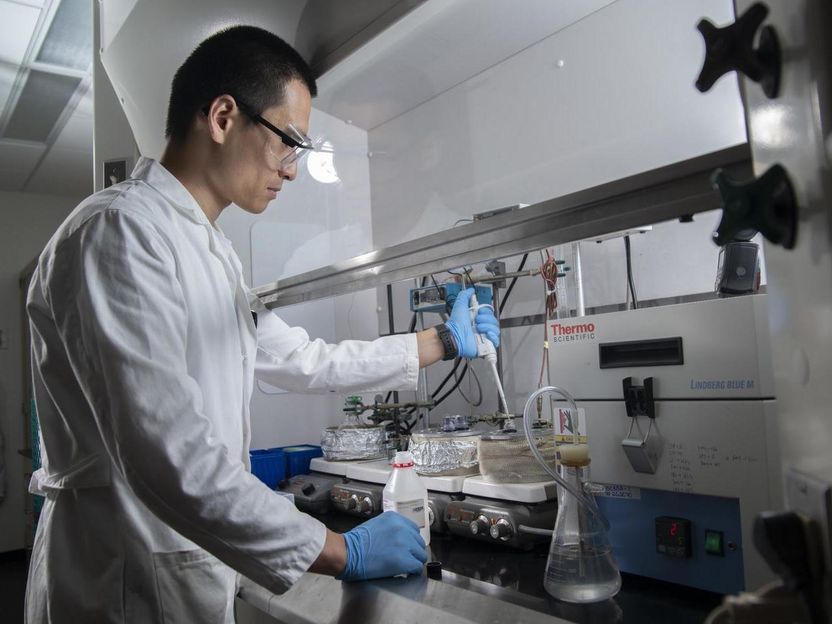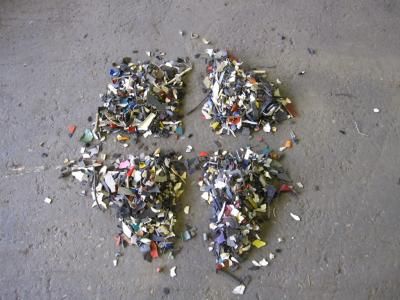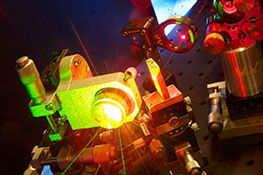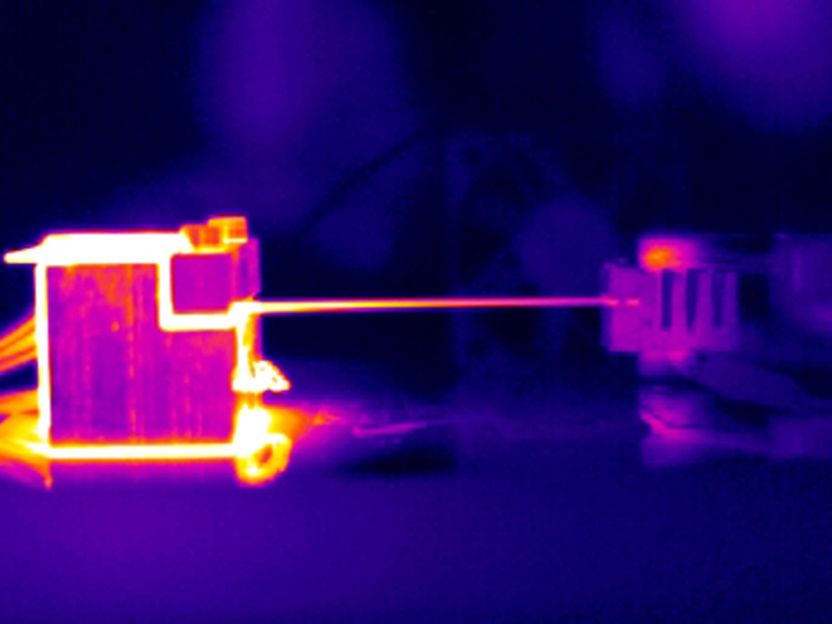Selenium anchors could improve durability of platinum fuel cell catalysts
platinum has long been used as a catalyst to enable the oxidation reduction reaction at the center of fuel cell technology. But the metal's high cost is one factor that has hindered fuel cells from competing with cheaper ways of powering automobiles and homes.

Zhengming Cao, a visiting graduate student at Georgia Tech, is working on technology that could improve the durability of fuel cell catalysts.
Christopher Moore
Now researchers at the Georgia Institute of Technology have developed a new platinum-based catalytic system that is far more durable than traditional commercial systems and has a potentially longer lifespan. The new system could, over the long term, reduce the cost of producing fuel cells.
In the study, which was published July 15 in the ACS journal Nano Letters, the researchers described a possible new way to solve one of the key causes of degradation of platinum catalysts, sintering, a process in which particles of platinum migrate and clump together, reducing the specific surface area of the platinum and causing the catalytic activity to drop.
To reduce such sintering, the researchers devised a method to anchor the platinum particles to their carbon support material using bits of the element selenium.
"There are strategies out there to mitigate sintering, such as using platinum particles that are uniform in size to reduce chemical instability among them," said Zhengming Cao, a visiting graduate student at Georgia Tech. "This new method using selenium results in a strong metal-support interaction between platinum and the carbon support material and thus remarkably enhanced durability. At the same time, the platinum particles can be used and kept at a small to attain high catalytic activity from the increased specific surface area."
The process starts by loading nanoscale spheres of selenium onto the surface of a commercial carbon support. The selenium is then melted under high temperatures so that it spreads and uniformly covers the surface of the carbon. Then, the selenium is reacted with a salt precursor to platinum to generate particles of platinum smaller than two nanometers in diameter and evenly distributed across the carbon surface.
The covalent interaction between the selenium and platinum provides a strong link to stably anchor the platinum particles to the carbon.
"The resulting catalyst system was remarkable both for its high activity as a catalyst as well as its durability," said Younan Xia, professor and Brock Family Chair in the Wallace H. Coulter Department of Biomedical Engineering at Georgia Tech and Emory University.
Because of the increased specific surface area of the nanoscale platinum, the new catalytic system initially showed catalytic activity three and a half times higher than the pristine value of a state-of-the-art commercial platinum-carbon catalyst. Then, the research team tested the catalytic system using an accelerated durability test. Even after 20,000 cycles of electropotential sweeping, the new system still provided a catalytic activity more than three times that of the commercial system.
The researchers used transmission electron microscopy at different stages of the durability test to examine why catalytic activity remained so high. They found that the selenium anchors were effective in keeping most of the platinum particles in place.
"After 20,000 cycles, most of the particles remained on the carbon support without detachment or aggregation," Cao said. "We believe this type of catalytic system holds great potential as a scalable way to increase the durability and activity of platinum catalysts and eventually improve the feasibility of using fuel cells for a wider range of applications."
Original publication
Original publication
Haoyan Cheng, Zhenming Cao, Zitao Chen, Ming Zhao, Minghao Xie, Zhiheng Lyu, Zhihong Zhu, Miaofang Chi and Younan Xia; "Catalytic System Based on Sub-2 nm Pt Particles and Its Extraordinary Activity and Durability for Oxygen Reduction"; Nano Letters; July 2019.
Organizations
Other news from the department science

Get the chemical industry in your inbox
By submitting this form you agree that LUMITOS AG will send you the newsletter(s) selected above by email. Your data will not be passed on to third parties. Your data will be stored and processed in accordance with our data protection regulations. LUMITOS may contact you by email for the purpose of advertising or market and opinion surveys. You can revoke your consent at any time without giving reasons to LUMITOS AG, Ernst-Augustin-Str. 2, 12489 Berlin, Germany or by e-mail at revoke@lumitos.com with effect for the future. In addition, each email contains a link to unsubscribe from the corresponding newsletter.
Most read news
More news from our other portals
Last viewed contents
Roche and Prionics announce collaboration in the field of BSE tests
SCG-DOW Group Commemorates Thailand HPPO Progress with Stone Laying Ceremony - PO facility at Map Ta Phut on schedule to start up in 2011

Plastics in electrical waste: Disposal or recycling?
The Linde Group to invest in largest air separation plant in India - EUR 85 million investment is part of a long-term gas supply contract with Tata Steel
Chromatin and Pacific Ethanol sign agreement for locally-grown sorghum in ethanol production
AkzoNobel announces intention to restructure and split ICI Pakistan

GLW Storing Systems GmbH - Würzburg, Germany

Diamonds are a laser scientist’s new best friend - Once a James Bond fantasy, diamond-based lasers are now becoming a reality





























































